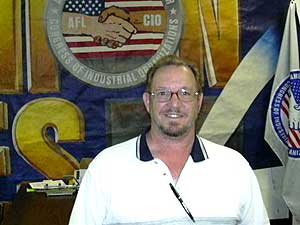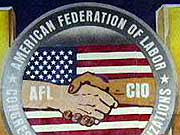A study in contrasts
January 27, 2004
 |
| Dave Kemnitz is president of the North Dakota AFL-CIO. "It's a question of power," says Kemnitz. "Who has it, who's keeping it, and who won't share it." (MPR Photo/Bob Reha) |
Moorhead, Minn. — North Dakota and Minnesota share more than a border. Both states are linked by their economies. North Dakota grew wheat that was milled in Minnesota. Those mills created jobs and an industrial base. Minnesota had a work force open to the idea of unions.
Each state has a history of grassroots activism. But North Dakota is a farm state with very little industry. Early in the 20th century, North Dakota farmers were disgusted with high interest rates and low prices. They blamed bankers, railroads and mill owners.
Their frustration resulted not in a union, but in a prairie revolution. They helped organize the Non-Partisan League. The candidates from this new political party won elections and took control of state government. They even created a state-owned bank and grain mill.
Both businesses remain open today, and some say the conditions that spawned the Non-Partisan League still exist.
 | |||
"It's a question of power," says Dave Kemnitz, president of the North Dakota AFL-CIO. "Who has it, who's keeping it and who won't share it."
Unions have had limited success in North Dakota. Just 8 percent of workers in North Dakota belong to unions.
There are strong trade unions in places like Fargo, Grand Forks and Bismarck. But workers at the state and county levels are a different story. Workers can join a union, but it won't help them at the negotiating table. Kemnitz says that's because North Dakota is a right-to-work state, and there is no negotiating table.
"In North Dakota, the state has not been given the wherewithal to recognize the union as a collective bargaining agent for a group of people," says Kemnitz. "So agency after agency can ignore an attempt by employees to form and join unions, and then collectively address their employer."
Kemnitz says unions have challenged the state in court on the collective bargaining issue. The North Dakota Supreme Court ruled in favor of the state, so nothing changed.
 | |||
Agriculture is North Dakota's largest industry. But farmers can be a difficult group to organize, even for unions. The National Farmers Union was organized in 1902. Karl Limvere worked for the Farmer's Union for 27 years. He says farmers have a very different definition of the word union.
"The word union really meant united group. It didn't have the same connotation that we have today, when we think of a union as organized labor," says Limvere. "At that time, union was just another way of saying a club. In fact, Farmers Union initially was a fraternal organization."
Limvere says farmers in North Dakota have tried to organize in ways that could influence their livelihood. He says farmer owned co-ops are an example.
In North Dakota, about 30,000 residents are union members, only a fraction of union membership in Minnesota, which is listed at 400,000. Limvere says the numbers are lopsided for a simple reason.
"North Dakota did not have an industry that could be easily unionized. Much of the DFL history comes out of northern Minnesota, where they had a large mining industry," says Limvere. "Iron ore mining, and they had a lumber industry, so you had people who could be organized on an industry base. North Dakota didn't have anything comparable."
|
Individual effort and individual responsibility is really a defining value for (North Dakotans) ... it's easy to argue against collective action. Because where is the individual responsibility in collective action?
- History professor Mike Card |
Some historians say there are other reasons that contribute to an anti-union attitude. Mike Card, history professor at the University of South Dakota, says some people are suspicious of unions. In a region where people think of themselves as self-reliant and independent, the idea of a union is a tough sell.
"Individual effort and individual responsibility is really a defining value for us," says Card. "When you throw some notion of collective action into that, it's easy to argue against collective action. Because where is the individual responsibility in collective action?"
Card says it's ironic that while North Dakotans support a state-owned bank, private groups that support collective action are viewed as a threat.
"What that reflects to many in this area of the country is that it just seems to smack of socialism or communism -- the whole notion of collectively working," says Card. "I think if you throw up the red flag -- literally -- that these organizations are socialist or communist, most people would believe that. Simply because of their collective action."
In Minnesota, that doesn't appear to be a problem. Bill Moore, a spokesman for the Minnesota AFL-CIO, says unions have worked to protect their rights. Moore says it helps that Minnesota has no right-to-work law.
"We also have a public employee law that went into place back in 1973," says Moore. "That's made it easier for school teachers and public employees to organize."
Moore says there is plenty of anti-union sentiment in Minnesota, it's just a bit more subtle.
"Usually employers are clever about that. They don't go on camera," says Moore. "A lot of their stuff goes on behind closed doors and in back rooms. A quiet kind of intimidation."
 | |||
Union organizers face a new kind of challenge -- a changing work force. Peter Rachleff, a history professor at Macalester College in St. Paul, says unions must change the way they organize. He says in the past union leaders have been slow to embrace change. But new factors are at play.
"Four years ago, hotel workers in Minneapolis and Bloomington struck nine hotels -- 1,500 workers went out on strike. Those 1,500 workers spoke 17 different languages," says Rachleff. "There were organizers inside the hotel and restaurant workers union here who found translators in community groups, put literature out in all of those languages."
It's not just the face of workers that's changing. So is the economy. Manufacturing jobs, long at the core of union strength, have disappeared. Historian Mike Card says the irony is, the key for unions to remain viable might be in their past. Card says traditional issues like workplace safety remain fertile ground for organizers.
"Even with computer programmers -- we might laugh about floppy disc wrist and carpal tunnel syndrome, but there are real injuries in the service sector that are just as debilitating," says Card. "And if workers collectively bargain workplace safety issues, there will be room for union activity -- even in North Dakota."
Union leaders admit getting their members to accept change is difficult. But they say if unions want to remain viable, they have to adjust their approach to organizing. They realize the survival of unions may depend on it.
|
News Headlines
|
Related Subjects
|

